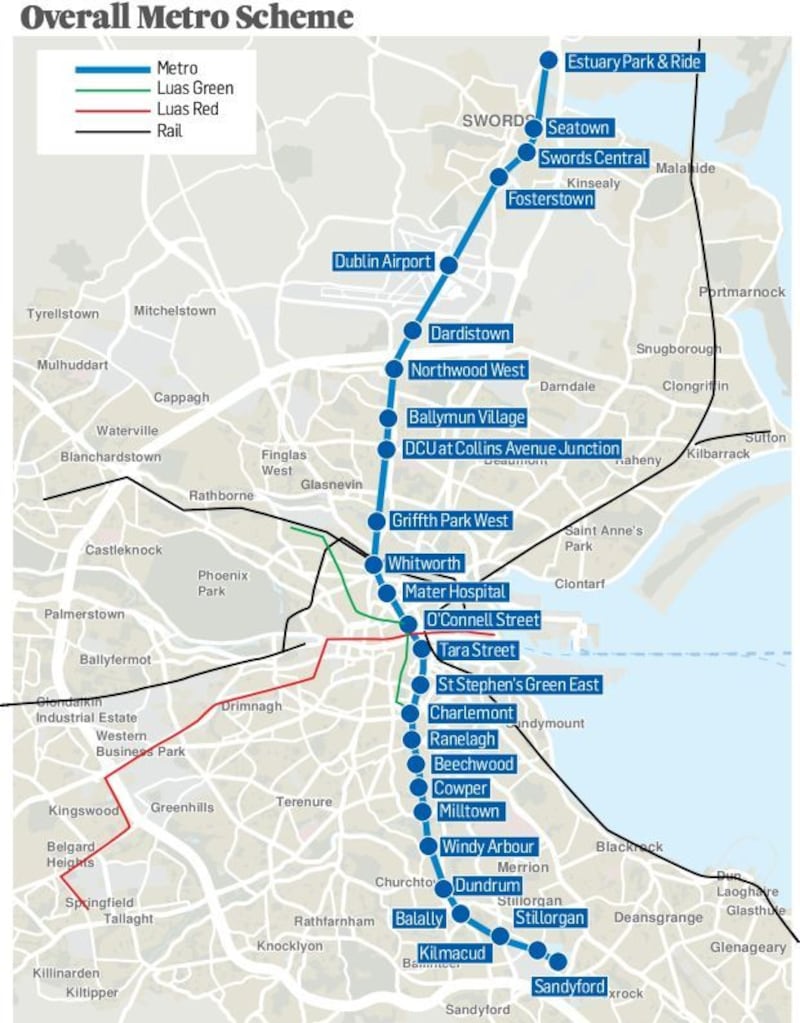Last March, when the National Transport Authority (NTA) published its preferred route for the Metrolink rail line, there was consternation in south Dublin over plans to replace the existing Green Luas line.
The contentious element was the proposal to have the new underground line pop up at the Luas Charlemont stop and run south, above ground, along what is currently the Green line.
Unlike trams the metro trains run at high speed and require segregation from other traffic, which isn’t a problem on most of the line south of Charlemont, with a handful of exceptions, most notably at the Beechwood stop where the NTA proposed to close the through-road from Dunville Avenue to Beechwood Road.
This proposal met strenuous opposition from almost 30 residents groups, in addition to individual residents, and politicians, including Minister for Housing Eoghan Murphy and former minister for justice Michael McDowell. It was claimed the project would split communities, would compound already terrible traffic, and force motorists into a 1.2km detour through Ranelagh village.
Following this pressure, the NTA last summer agreed to review the line to avoid the road closure, and it is now understood to be planning to keep the line underground until it has travelled south of the Beechwood stop.
Battle
Road open – case closed, some observers might assume, but for the Rethink Metrolink campaign the battle against the “Berlin Wall” of the southside rages on.
“Dunville Avenue was our initial concern, but we are of the view that the route needs to stay underground until it has passed all established residential neighbourhoods,” Rethink Metrolink spokesman Pat Galvin said.
Mr Galvin said he was particularly concerned about the lack of awareness by Luas users of the impending disruption to the line.

“We have been distributing our information leaflet early mornings at Luas stops and most people did not know the line would be segregated and did not know the Luas would be closed for between nine months and two years of construction work.”
A spokesman for the NTA said it had not issued any timelines in relation to stop or line closures. Mr Galvin said these estimates were based on the construction of similar projects.
“It is not acceptable that a heavy rail line would come up in a Victorian neighbourhood like Ranelagh and Rathmines, but this is more than just a local issue,” he said. “We are all for transport infrastructure, but this plan simply replaces an existing line, when other areas such as Templeogue to the west, or UCD to the east, could be served by an underground line.”
Alternative routes
Green Party leader Eamon Ryan agrees the NTA should consider alternative routes.
“We are in a crisis in transport in the the city. Even in the last six months gridlock has shot off the Richter scale. I just think we should grasp the opportunity to think bigger.”
He said instead of replacing the Luas Green line with the metro, the NTA should consider two options: one to keep the line underground and run it from Charlemont to Rathmines, Terenure and Rathfarnham; or otherwise to head east underground to UCD and then south on land reserved for the Eastern bypass towards Sandyford.
Either option would relieve “terrible traffic congestion”, with the Rathfarnham option in particular tackling what was “the worst public transport black spot in our city”.
While Mr Ryan’s proposals would likely cost more, he said the outlay would pay dividends in the long run.
Boring machine
“Getting the tunnel boring machine into the ground is where the real costs lie, so just keep it in the ground. It’s not good enough to say it will cost more. It’s a win-win situation. It may cost €500 million or €600 million but in the long term you get huge bang for your buck.”
These large scale changes would not necessarily create delays for the project, Mr Ryan said as the NTA could pursue the northern sections of the line and give an indicative outline of the southside which could then be subject to more detailed designs.
The NTA’s revisions of its route would not include consideration of entirely new lines. the authority said. However Mr Ryan said: “The NTA does not have the final call – they have to get political direction.”
Demolition
In the city centre, the residents of the College Gate apartment complex remain hopeful that the NTA will reverse plans to demolish their homes. The block of 70 apartments, and the Markievicz leisure centre beneath them, were earmarked for demolition in the plans published last March
"There are alternatives to demolishing our apartments and we are still hopeful the NTA will use them. We are waiting to see what they will produce in January or February, but if there is any more delay than that we will make our voices heard," Nicola Brait of the Save College Gate campaign said.
A spokesman for the NTA said public consultation following the publication of the preferred route “informed the process and the issues raised need to be worked through”.
“As a result, the National Transport Authority [NTA] and Transport Infrastructure Ireland look forward toward updating the public and answering their concerns directly during the next round of public consultation.”








